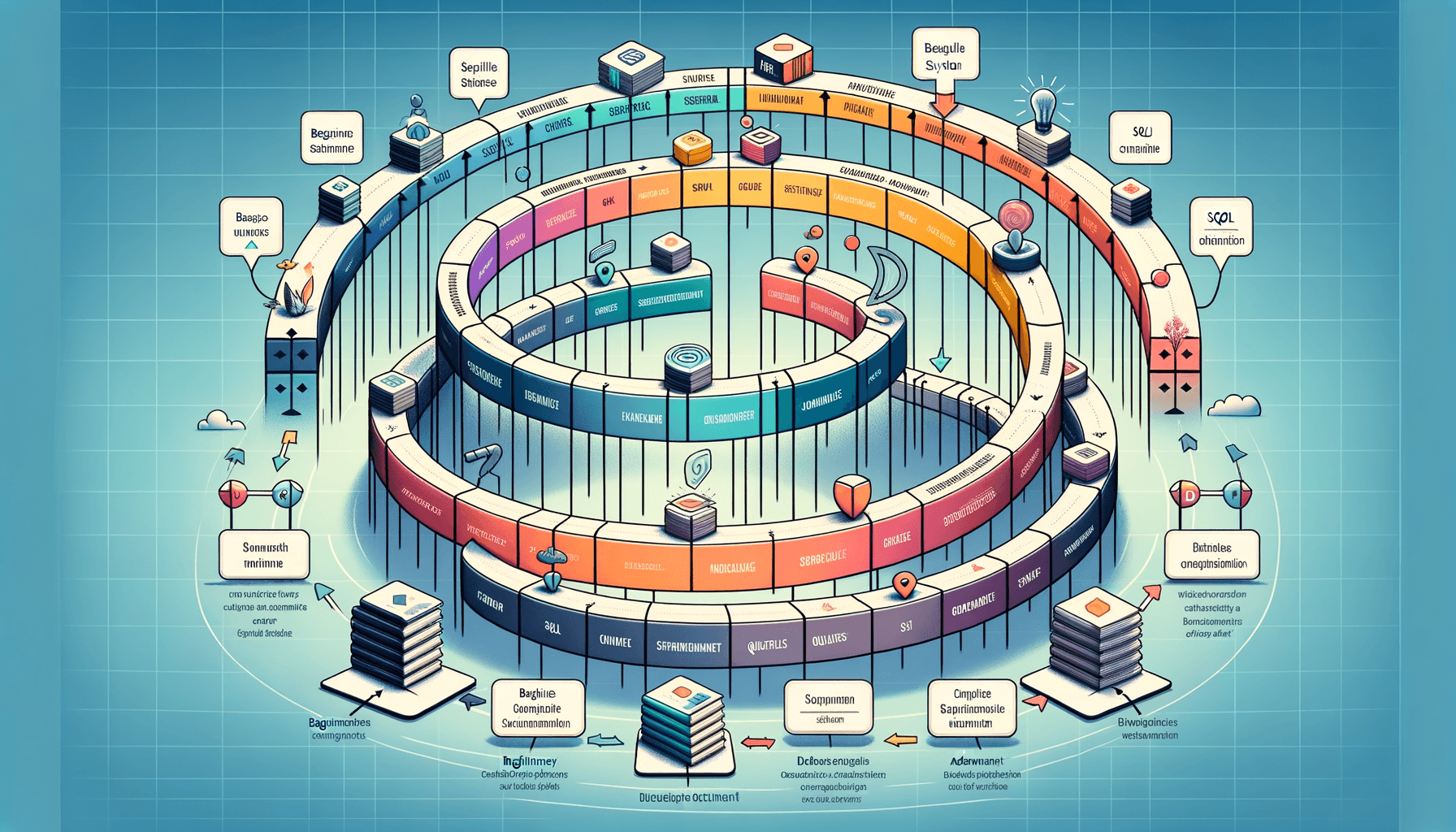A big variety of articles and resources

An In-Depth Exploration of Query Language Topics for Database Enthusiasts
 Sia Author and Instructor
Learn SQL
Sia Author and Instructor
Learn SQL
11 minute read
Query languages are like special codes that help us talk to databases. They have changed a lot over the years, from simple beginnings to the powerful tools we use today. This article will take you through their history, basic ideas, and how they work with big data. We will also look at security issues and what the future might hold for these languages.
Key Takeaways
- Query languages help us talk to databases and have evolved a lot over time.
- There are many types of query languages, each with its own strengths and uses.
- Knowing the basics like syntax, data retrieval, and optimization is important.
- Security is a big concern with query languages, including threats like SQL injection.
- The future of query languages looks exciting with AI, machine learning, and more.
Historical Evolution of Query Languages
Early Developments in Query Languages
In the early days of computing, query languages were rudimentary and often specific to particular systems. These early languages laid the groundwork for more sophisticated data retrieval methods. They were primarily used for simple data manipulation and retrieval tasks.
The Rise of SQL
The introduction of SQL (Structured Query Language) in the 1970s marked a significant milestone. SQL became the standard language for relational database management systems (RDBMS). Its ease of use and powerful capabilities made it widely adopted across various industries. SQL's declarative nature allowed users to specify what data they wanted without detailing how to retrieve it.
Modern Query Language Innovations
In recent years, we have seen a surge in new query languages designed to handle diverse data types and structures. These modern innovations include NoSQL databases, which cater to unstructured data, and graph query languages like Cypher for querying graph databases. These advancements have expanded the possibilities for data analysis and manipulation, making it easier to work with complex datasets.
The evolution of query languages reflects the growing complexity and diversity of data in the digital age. As our data needs continue to evolve, so too will the languages we use to query and manage that data.
Fundamental Concepts in Query Languages
Syntax and Semantics
When we talk about query languages, understanding their syntax and semantics is crucial. Syntax refers to the rules that define the structure of queries, while semantics deals with the meaning behind those queries. Mastering both aspects is essential for writing effective queries. Think of syntax as the grammar of a language and semantics as the meaning conveyed by the sentences.
Data Retrieval Techniques
Data retrieval is at the heart of query languages. Various techniques are used to fetch data from databases, including simple SELECT statements and more complex joins and subqueries. These techniques allow us to extract the exact information we need from vast datasets.
Query Optimization
Query optimization is all about making queries run faster and more efficiently. This involves choosing the best execution plan and minimizing resource usage. Some common optimization techniques include indexing, query rewriting, and using efficient algorithms. By focusing on optimization, we can significantly improve the performance of our database systems.
Understanding these fundamental concepts is the first step towards becoming proficient in query languages. They form the foundation upon which more advanced topics are built.
Comparative Analysis of Query Languages
SQL vs NoSQL
When comparing SQL and NoSQL, we notice that each has its own strengths and weaknesses. SQL databases are known for their structured data and powerful query capabilities. They use a fixed schema, which makes them ideal for applications requiring complex queries and transactions. On the other hand, NoSQL databases offer flexibility with their schema-less design, making them suitable for handling unstructured data and scaling horizontally. Choosing between SQL and NoSQL often depends on the specific needs of the application.
Graph Query Languages
Graph query languages, such as Cypher for Neo4j, are designed to handle data that is interconnected. These languages excel in querying relationships between data points, which is something traditional SQL databases struggle with. Graph databases are particularly useful in social networks, recommendation systems, and network analysis. They allow us to traverse relationships efficiently, providing insights that would be difficult to obtain using other query languages.
Query Language Performance Metrics
Performance metrics are crucial when evaluating query languages. We often look at factors like query execution time, resource usage, and scalability. For instance, SQL databases might perform better in transactional systems, while NoSQL databases could excel in read-heavy applications. It's important to consider these metrics to ensure the chosen query language meets the performance requirements of the application.
Understanding the strengths and limitations of different query languages helps us make informed decisions when designing and optimizing databases.
Advanced Query Language Features
Nested Queries
Nested queries, also known as subqueries, allow us to embed one query within another. This feature is particularly useful when we need to perform complex filtering or when we want to break down a problem into smaller, more manageable parts. By using nested queries, we can create more dynamic and flexible database interactions. For example, we might use a subquery to first find a set of records and then use those results in the main query to further refine our data selection.
Window Functions
Window functions are a powerful tool in SQL that enable us to perform calculations across a set of table rows related to the current row. Unlike aggregate functions, window functions do not cause rows to become grouped into a single output row. Instead, they maintain the individual rows while allowing for complex calculations like running totals, moving averages, and ranking. This makes them invaluable for data analysis tasks where we need to look at trends over a series of rows.
User-Defined Functions
User-defined functions (UDFs) allow us to extend the capabilities of SQL by writing custom functions tailored to our specific needs. These functions can be written in various programming languages, such as SQL, Python, or JavaScript, and can be used to encapsulate complex logic that can be reused across multiple queries. UDFs are particularly useful for performing repetitive tasks or for implementing business logic that is not natively supported by the database system.
Mastering advanced query language features like nested queries, window functions, and user-defined functions can significantly enhance our ability to manipulate and analyze data effectively.
Security Considerations in Query Languages
SQL Injection Attacks
SQL injection attacks are a major threat to databases. They happen when attackers insert malicious SQL code into queries. This can lead to unauthorized access or data loss. Understanding how to prevent these attacks is crucial for database security. We must validate user inputs and use prepared statements to mitigate these risks.
Access Control Mechanisms
Access control mechanisms help us manage who can view or change data in a database. These mechanisms include user roles and permissions. By setting up proper access controls, we can ensure that only authorized users can perform certain actions. This is essential for maintaining data integrity and security.
Data Encryption Techniques
Data encryption techniques protect sensitive information by converting it into unreadable code. This ensures that even if data is intercepted, it cannot be understood without the decryption key. We should use encryption for both data at rest and data in transit to safeguard our databases.
In our mini course: SQL query expansion, we cover advanced SQL techniques, including security measures like encryption and access control. This is designed for senior database engineers and IT project managers who need to secure relational databases effectively.
Query Languages in Big Data
Handling Large Datasets
When dealing with big data, the sheer volume of information can be overwhelming. We need efficient query languages to manage and retrieve data from these massive datasets. Scalability is a key factor here, as traditional databases often struggle with the size and complexity of big data. Techniques like partitioning and indexing help in breaking down large datasets into manageable chunks.
Distributed Query Processing
In a big data environment, data is often spread across multiple servers or even different geographical locations. Distributed query processing allows us to run queries across these various nodes, ensuring that we can access and analyze data no matter where it is stored. This approach not only improves performance but also enhances fault tolerance, making the system more robust.
Real-Time Querying
Real-time querying is essential for applications that require immediate insights from data. Whether it's monitoring system performance or tracking user behavior, the ability to query data in real-time can provide significant advantages. Technologies like in-memory databases and stream processing frameworks enable us to achieve this level of responsiveness. Latency is a critical factor here, as even slight delays can impact the effectiveness of real-time querying.
In the realm of big data, the ability to efficiently query and analyze vast amounts of information is not just a luxury but a necessity. As data continues to grow, so does the need for advanced query languages that can keep up with the demands of modern applications.
Future Trends in Query Languages
AI and Machine Learning Integration
As we look ahead, the integration of AI and machine learning into query languages is becoming increasingly significant. These technologies can help automate query optimization, making data retrieval faster and more efficient. AI-driven query languages can also adapt to user behavior, providing more accurate and relevant results over time.
Natural Language Processing
Natural Language Processing (NLP) is another exciting trend. With NLP, users can interact with databases using everyday language, making data querying more accessible to non-technical users. This shift could democratize data access, allowing more people to gain insights without needing to learn complex query syntax.
Quantum Computing Implications
Quantum computing holds the potential to revolutionize query languages. With its ability to process vast amounts of data at unprecedented speeds, quantum computing could make current query optimization techniques obsolete. While still in its early stages, the implications for data processing and retrieval are profound.
The future of query languages is bright, with advancements in AI, NLP, and quantum computing promising to transform how we interact with and retrieve data. As these technologies evolve, we can expect more intuitive, efficient, and powerful query languages to emerge.
The future of query languages is evolving rapidly, with new trends emerging that promise to make data retrieval more efficient and user-friendly. If you're eager to stay ahead of the curve and enhance your skills, our courses are the perfect place to start. Visit our website to explore our offerings and find the right course for you. Don't miss out on the opportunity to advance your knowledge and career!
Conclusion
In summary, exploring query languages opens up a world of possibilities for database enthusiasts. From understanding the basics to diving into advanced topics, there's always something new to learn. Query languages are the backbone of database management, making it easier to retrieve, update, and manage data. As technology evolves, so do these languages, offering more efficient and powerful ways to handle data. For anyone passionate about databases, mastering query languages is not just beneficial but essential. Keep learning and experimenting, and you'll find that the world of databases is as exciting as it is vast.
Frequently Asked Questions
What are query languages?
Query languages are used to ask questions and get information from databases. They help you find, add, or change data easily.
Why is SQL so popular?
SQL is popular because it's easy to learn and use. It works well with most databases and has been around for a long time.
What is the difference between SQL and NoSQL?
SQL uses tables to store data, while NoSQL uses different methods like documents or graphs. NoSQL is often better for handling big amounts of data.
How do query languages keep data safe?
Query languages use different ways to keep data safe, like checking who can see or change the data and using codes to protect it from hackers.
Can query languages handle big data?
Yes, some query languages are made to work with big data. They can manage large amounts of information and process it quickly.
What is the future of query languages?
The future of query languages looks exciting with new ideas like AI, natural language, and even quantum computing. These can make it easier to ask questions and get answers from databases.
Related Articles

Exploring the Data Topic: Key Insights and Trends
9 minute read






